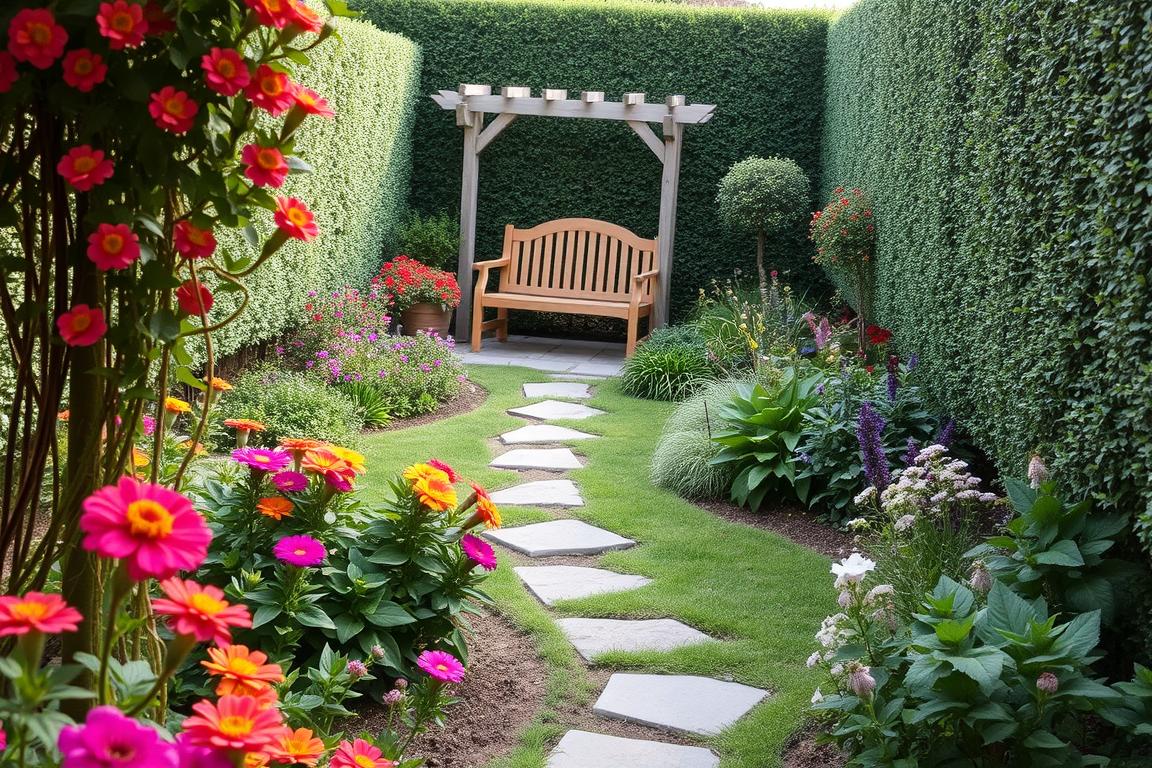Creating a thriving garden starts with preparing the soil. It’s important to make sure your soil has the right nutrients and water for plants to grow well. By following the best practices, you can make your garden a success.
As you prepare your soil, you’ll learn why it’s so important. You’ll also find out how to check your soil’s quality and improve it. Whether you’re a seasoned gardener or new to it, knowing how to prepare the soil is key to a healthy garden.
Table of Contents
ToggleIntroduction to Garden Soil Preparation
Preparing your garden soil is vital for your plants to grow well. By using the best practices, you can give your plants the nutrients and water they need. This article will show you how to prepare your soil, including understanding its importance and checking its quality.
Key Takeaways
- Preparation is key to a thriving garden
- Garden soil preparation involves ensuring necessary nutrients and water
- Best soil preparation practices lead to optimal plant growth
- Assessing current soil quality is critical for garden soil preparation
- Garden soil preparation affects plant health and growth
Understanding the Importance of Garden Soil Preparation
When you start planting your garden, remember how important soil is. Organic soil tips can make your soil better for plants. This helps your garden grow well.
Preparing your soil means investing in your plants’ health. Improving soil fertility helps plants get the nutrients they need. Adding organic matter and natural amendments helps plants grow strong.
- Soil composition and structure
- Nutrient availability and pH levels
- Presence of organic matter and microorganisms
Understanding these factors helps you make your garden better. Optimizing soil health takes time and effort. But it’s worth it for a healthy, productive garden.
By taking a holistic approach to garden soil preparation, you can create a thriving ecosystem that supports healthy plant growth and contributes to a more sustainable environment.
Assessing Your Current Soil Quality
Understanding your soil quality is key for garden bed preparation. You need to check the soil’s pH level, nutrient content, and structure. This helps you see what needs improvement and plan to make the soil healthy. Soil amendment techniques can fix any issues found in the soil.
To start, you should do a soil test. Take a soil sample from your garden bed and send it to a lab for analysis. The lab will tell you about your soil’s pH, nutrients, and structure. This info helps you know how to make your soil better for your plants.

- Soil type: Is it clay-based, sandy, or a mix?
- pH level: Is it acidic, alkaline, or neutral?
- Nutrient content: Are there any nutrient shortages or too much?
Knowing these details lets you plan to make your soil healthy. You can use soil amendment techniques and other methods. This will help your garden grow well with little care and give you strong, healthy plants.
Gathering the Necessary Tools and Materials
Getting ready for garden soil preparation means having the right tools and materials. You need essential gardening tools and soil amendments for a fertile ground. The right equipment is key for the best soil preparation.
You’ll need a shovel, rake, and trowel for digging, mixing, and aerating the soil. These tools are vital for preparing the soil for planting. You’ll also need soil amendments and nutrients to make the soil fertile and structured.
When picking soil amendments, think about your garden’s needs. If your soil lacks nutrients, add compost or manure. For dense or heavy soil, use perlite or vermiculite for better drainage and aeration. Using the right tools and materials will help you create a healthy garden.
Here are some key things to consider when gathering your tools and materials:
- Choose high-quality gardening tools that will last for a long time
- Select soil amendments that are specific to your soil type
- Follow the instructions for applying soil amendments and nutrients
By gathering the right tools and materials, you’re on your way to a beautiful garden. Always follow best soil preparation practices. Take the time to prepare your soil well, and you’ll have a thriving garden.
Clearing Out Weeds and Debris
Preparing your garden soil means getting rid of weeds and debris. Weeds take water and nutrients from your plants. Debris can attract pests and diseases. Removing these obstacles helps your plants grow better.
There are ways to deal with weeds. Physical removal means pulling or digging them up. It’s a bit hard but doesn’t use chemicals. You can also use mulch or compost to stop weeds from growing. This also makes the soil better.

To keep weeds away, try crop rotation and cover cropping. These methods make the soil better and reduce weeds. By using these tips, your garden will be healthy and strong.
- Remove weeds by their roots to prevent regrowth
- Use mulch or compost to suppress weed growth
- Implement crop rotation and cover cropping to improve soil fertility and reduce weed growth
Clearing weeds and debris is key to a great garden. It sets you up for success. You’ll enjoy a garden that’s healthy and strong because of good soil care.
Tilling and Aerating the Soil
Preparing your garden bed starts with healthy soil. This means loosening and breaking up compacted soil. Tilling is key to this, as it improves soil structure and boosts oxygen flow. This makes it easier for roots to grow and get nutrients.
Aerating is another important step. It also improves soil structure and increases oxygen flow. By using tools like manual or mechanical aerators, you can loosen and aerate the soil. This creates a fertile soil environment for healthy plant growth.
Some benefits of tilling and aerating your garden bed include:
- Improved soil drainage and aeration
- Increased oxygen flow and root growth
- Enhanced soil structure and fertility
- Reduced soil compaction and erosion
By using these techniques, you can make your garden a thriving ecosystem. Choose the right tools and techniques for your soil and garden. If you’re unsure, ask gardening experts for advice.
Adding Organic Matter to Enhance Soil
When you’re getting your garden ready for planting, adding organic matter is key. It boosts soil fertility and health. This makes your garden a great place for plants to grow.
There are many ways to add organic matter. You can use compost, manure, or peat moss. These help with soil structure, nutrient availability, and support good microorganisms. Here are some tips:
- Choose the right compost: Look for compost that is rich in nutrients and has a balanced pH level.
- Use manure wisely: Manure can be a valuable source of nutrients, but it’s essential to use it in moderation to avoid over-fertilizing your soil.
- Consider peat moss: Peat moss can help improve soil structure and retain moisture, but it’s essential to use it in combination with other amendments to avoid acidifying your soil.

By following these tips and adding organic matter, you can make your garden healthy and thriving. Always focus on improving soil fertility and health for a great harvest.
Balancing Soil pH for Optimal Growth
Understanding pH levels is key in garden soil preparation. Most plants do well in slightly acidic to neutral soil pH. Adjusting the pH with amendments is a big part of best soil preparation practices.
To get the best growth, balance your soil’s pH. First, find out your soil’s current pH. Then, make changes as needed. Adding lime or sulfur can help make your soil perfect for plants.
Here are some tips for adjusting soil pH:
- Test your soil regularly to determine its pH level
- Use lime to increase the pH of acidic soils
- Use sulfur to decrease the pH of alkaline soils
- Monitor your soil’s pH levels over time to ensure optimal growth
By following best soil preparation practices and adjusting your soil’s pH, you can make a great place for plants to grow. Remember, preparing soil for gardening is a continuous effort. It needs careful attention and a dedication to giving your plants the best chance to thrive.

Best Practices for Sustainable Soil Preparation
Preparing your garden bed with sustainable methods is key to healthy soil. It’s all about long-term care, focusing on making the soil fertile and structured. Crop rotation and cover crops are top ways to do this.
Crop Rotation Benefits
Crop rotation brings many advantages, like better soil structure and more nutrients. It helps break disease and pest cycles, cutting down on fertilizers and pesticides. Plus, it saves water and reduces soil compaction.
Using Cover Crops
Cover crops are great for healthy soil too. They add organic matter, making the soil better for plants. Legumes, grasses, and brassicas are good choices. Here’s why cover crops are beneficial:
- Improved soil erosion control
- Increased nutrient availability
- Enhanced soil biota

By using crop rotation and cover crops, you make your soil sustainable and healthy. Pick the right cover crops for your soil and climate. Rotate crops often to get the most benefits.
Ready for Planting: Final Checks
Now that your garden soil is ready, it’s time for the final steps before planting. Make sure the soil is moist and plan out where each plant will go. These steps are key to a successful garden.
Maintaining Ideal Soil Moisture
Soil moisture is vital for seeds to germinate and plants to grow well. Check the soil’s moisture by squeezing a handful. It should be damp, not wet. If it’s too dry, water it lightly and wait for it to absorb.
If the soil is too wet, let it dry a bit before planting. This ensures the best conditions for your plants.
Mapping Out Your Planting Layout
Plan the layout of your garden beds and rows carefully. This helps use your space well and lets plants grow as they should. Think about sun exposure, plant height, and growth habits when placing each plant.
FAQ
What is the importance of garden soil preparation?
Preparing your garden soil is key to a healthy garden. It makes sure your plants get the nutrients and water they need to grow well.
How do I assess the quality of my current soil?
Checking your soil’s quality is a first step. You can do a soil test to see its pH, nutrient levels, and structure. This tells you what needs fixing.
What tools and materials do I need for garden soil preparation?
You’ll need basic gardening tools like a shovel, rake, and trowel. Also, soil amendments and nutrients to make it better. Picking the right products is important.
How do I effectively clear out weeds and debris from my garden bed?
Getting rid of weeds and debris is vital. Use good weeding methods and dispose of weeds properly to stop them from coming back.
Why is tilling and aerating the soil important?
Tilling breaks up compacted soil. Aerating improves soil structure and lets in more oxygen. Both are essential for a healthy garden.
How do I add organic matter to enhance my soil?
Adding compost, manure, and peat moss can boost soil health. It’s important to choose the right organic amendments and apply them correctly.
How do I balance the pH of my soil for optimal plant growth?
Knowing about soil pH and adjusting it with lime or sulfur is important. It helps your plants grow well.
What are some best practices for sustainable soil preparation?
Practices like crop rotation and using cover crops help keep soil healthy. They reduce the need for fertilizers and pesticides.
What final checks should I make before planting?
Make sure the soil is moist and plan your planting layout. Use garden beds or rows for a neat look before planting.














